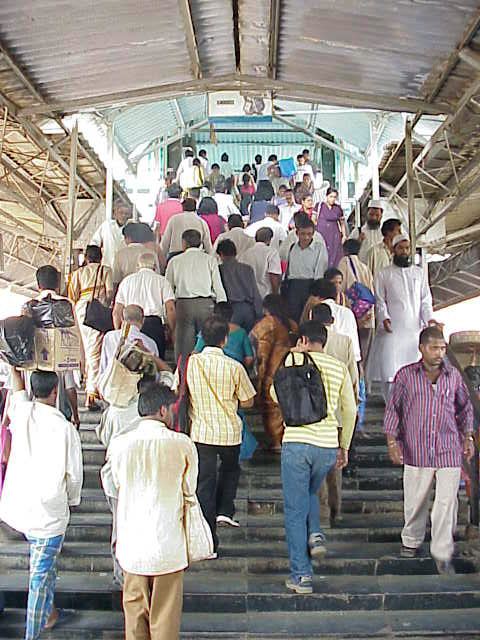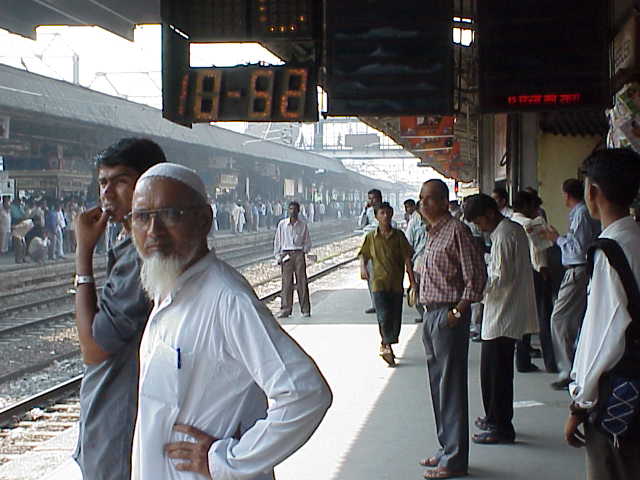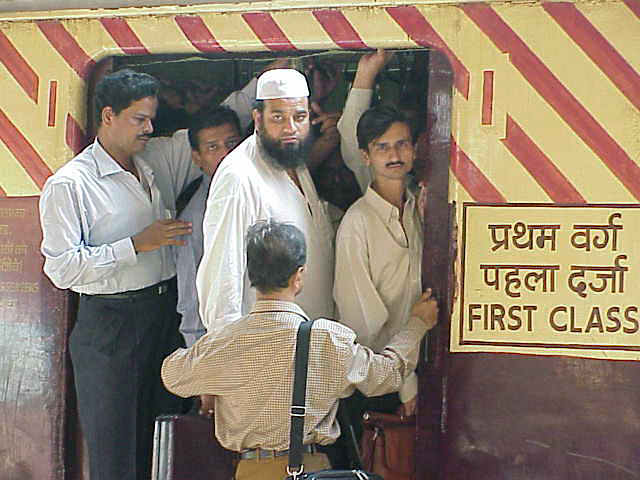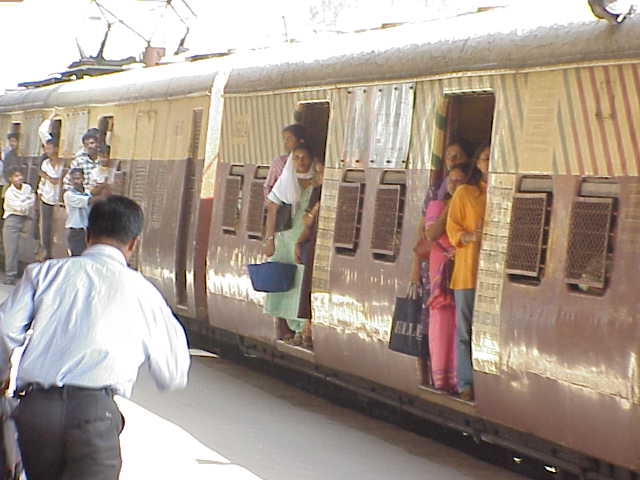Since we would be in Mumbai for a week, we decided we should use local transportation. We were staying near the airport, so the best choice was the Mumbai trains. If you thought college students of the 50’s were tightly crammed into telephone booths, you haven’t experienced the Mumbai commuter trains.


The first time we took a 2nd class train
car into the city, we gained that experience. I’d ridden domestic trains in India from city to city and they were usually comfortable, with assigned seats and a minimum of crowding in 2nd class. Here in Mumbai, it was a different species of train entirely. It was crowded even for a Sunday – some guys always leaning out the open doorways making it look like the press of the crowd is pushing them out, but it’s usually voluntary showing off.

Little kids on the train come up and stand silently
with a hand on your knee, waiting for a coin. Finally, they give up and move on to the next prospect. Getting off the train is reminiscent of the Greek ferries. There are no announcements on the train, or at least we didn’t hear any, and stops are short, so you have to be ready to get off. But when the train stops, the crowd outside immediately starts to try to get on. It’s a grand melee trying to get off with all attachments, while new folks are pressing inwards. It took us about 1 hr to get into town, less coming back by express. Once on board, it was crowded, but people were friendly and pleasant, a bit surprised to us on their trains.
The next day we took first class tickets,
for about double the 2nd class rate, raising the price to about 25c. The main difference seems to be a slightly better dress code, and somewhat less crowding, but still mostly standees. [Note: my pictures may seem no more crowded than US or UK subways, but that’s because when crowded I couldn’t reach my camera and would only have been able to photograph the backs of people right next to me!]
We rode in with suburban commuters while tiffin wallahs with their loads boarded special cars. This is an amazing enterprise – every day, suburban wives make their husbands lunch, a multi course meal stacked in aluminum tiffins. These are picked up, taken to the train station, then delivered to the workplace. More amazing, this is accomplished by mostly illiterate porters using a colored bead coding system. In the afternoon, the used tiffins are picked up and reverse their journey, arriving back in suburbia.
Audrey gets in the Ladies car again. No less crowded and still semi-polite pushing for breathing room.


As the train was already starting to pull away
from the main station, I ran and pushed into the nearest open door, only to realize it was second class. Luckily it was an express – I counted over 250 people in that one car, with seats for about 50. Another 50 people crammed into the central standing section alone. As usual, several young men were hanging out the door and just grabbing the overhang. I finally squirmed to a place near the seats, so I only had 3 people pressing against me. Couldn’t see anything outside.
My only hope was I’d remember the proper number of stops. At one station, I just heard “Dadar! Dadar! Dadar!…” from the passengers but usually I couldn’t see the station signs. As we approached our home station of Andheri, I started to make my move back through the press – no way anyone could have fallen. At the station it was a rugby scrum. The first wave surged off the train; I almost made it, but then got hit with the backwash from incoming patrons. And but a few more pushes and I squirted onto the platform, totally soaked with sweat, arms flailing behind me, camera case still floating behind me, but safe on the platform as the train continued its way.
Millions of people use these commuter lines daily,
and despite first appearances, they really do work. The development of the railway system in Mumbai played a significant role in the city’s growth and transformation into one of the largest metropolises in the world.
The first railway line in Mumbai was opened in 1853, connecting the city to Thane. The line was primarily intended for long-distance travel, but it soon became apparent that there was a need for a suburban railway network to cater to the growing population and expanding suburbs of Mumbai. In the early 1900s, the suburban railway network was expanded with the addition of several new lines, including the Western Line and the Central Line.

These lines were initially run with steam locomotives,
but in the 1920s, the system began to transition to electric trains. Electrification helped increase the efficiency, capacity, and reliability of the suburban railway network. When India gained independence in 1947, the railroad system was among the few positive carryovers from the British occupation. The suburban railway network underwent further expansion, connecting more areas and suburbs. The system played a crucial role in the city’s urbanization and now moves millions of people each day.
Mumbai’s suburban railway network faces numerous challenges, including overcrowding during peak hours (an understatement), accidents, and infrastructure issues. Unfortunately, accidents occur due to various factors, such as derailments, platform overcrowding, and monsoon-related incidents. NYTimes does report
“The overall number of major rail accidents — such as collisions, derailments and fires — has fallen by about two-thirds in the past decade, and casualties from such events have dwindled to double and single digits in recent years, official data shows.
Still, there are nearly 20,000 scattered rail-related deaths each year, many from things like falling from an overcrowded car or being struck by a train.”
These incidents have highlighted the need for continuous improvements and safety measures. Efforts to improve Mumbai’s trains system include the introduction of new trains, extension of existing lines, and construction of new lines to better connect suburbs and reduce congestion.